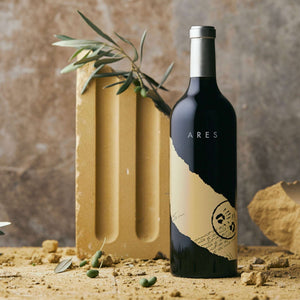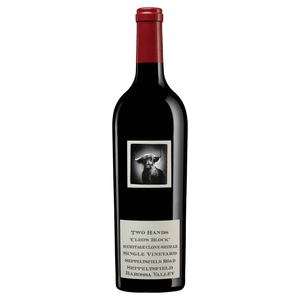Seppeltsfield Road links our winery, vineyards and cellar door, referred to by Barossa locals as “The Avenue of Hopes and Dreams”. It is magnificently lined with the iconic 100 year old date palm trees.
The philosophy applied to our estate vineyards is inspired by a seminal French producer from the Rhone Valley - to not own every vineyard, but to own the best. Time, patience, extensive soil studies and viticultural research have allowed our team to establish what we aspire to be one of the ultimate vineyards of Barossa, ‘The Holy Grail’.
The Holy Grail is a veritable viticulturist’s dream. The vineyard is planted to 22 individual blocks, each with its own unique micro-climate with specific clone, variety, row-orientation and trellis system planned in minute detail to ensure the absolute best quality wine is produced. Nothing is left to chance when it comes to the Holy Grail and The Clos block is a perfect example of this philosophy.
With additional fruit from our Kraehe House Block in Marananga, next to our Cellar Door, and the famous Coach House Block in Greenock, the combination of our existing blocks and new developments provides a fascinating contrast and will provide an enormous source of fruit styles for the winemaking team to work with as the vines mature over the years ahead.
Holy Grail Vineyard: Then and Now


Soil pits are dug 60 x 60 metres and soil analysis report is completed. Deep ripping of the vine rows to 1 metre and soil ameliorations of organic composts/manures and Gypsum is spread over the vine row to prepare the soils for planting. As well as installing irrigation and trellis systems. We let the winter rain fall and soak into our newly ripped vines rows.
Row Orientation
Trellis vines are planted 3.0m wide x 1.5m. Sur Echalas Vines are planted 2.0m x 1.25m. All vines were planted in early October. All planting material is selected on massale Selection basis of different Clones of Shiraz,
Grenache, Mourvedre and Cabernet Sauvignon. Planted east to west allowing the bunch zone of our vines to be shaded by the harsh afternoon summer sun. Allowing slow and consistent ripening. In September 60,000 vines were planted over two years.
Our Approach to Viticulture: Practices, Passion and Innovation

Soil Health
Each year our vineyard team disperse bails of straw mulch under our vines to keep the soil temperature and surface roots cool as well as retain valuable moisture in the soil. The mulch also promotes earthworm and soil microbe activity and also sees a reduction in weed growth which in turn lowers the need for harsh herbicides. We also sow selected species of perennial Medics or Burclover between the vine rows so their nitrogen goes back into the soil.

Sap Flow Technology
We have implemented sap flow sensors directly across our estate vineyard. The technology measures and monitors the transpiration of the vine and in turn assists the viticulture team to manage irrigation regimes ensuring the vines receive the right amount of water at the optimal time. Comparing traditional irrigation strategies to plant-sensor based irrigation, an average of 50% water savings could be achieved using this technology.

Scottish Highlanders
Our gorgeous Scottish Highland cattle aren’t just there for their good looks! Brutus and his family who live at Holy Grail vineyard, as well as 100% of the grape must from harvest contribute to the 300 tonnes of organic compost we add back into our vineyards each year, in order to support the natural balance within our vines.

Winter Pruning
Each winter the vine is pruned back to 2 canes. The pruner identifies the best canes to grow new shoots for the coming harvest. The new canes are wrapped to the fruiting wire & spurs are left around the head of the vine to create new canes for the following year. Our Sur Echalas Vines are pruned to two, four bud spurs. We receive most of our annual rainfall over winter, allowing the water to drain deep into the clay soils.

The Clos Block
The final block at Holy Grail was planted in 2017, The ‘Clos’ (pronounced KLOH). The Clos has 5807 vines across 3.6 acres. Situated on a relatively steep slope, the vines are planted across the hill, to help with erosion control, allow ease of spraying and it is easier to prune. The échalas style must be managed by hand. From bud-burst, the vines are tied to the 1.8-metre stake three times throughout the growing season until finally, the vines are joined together forming the shape of a love heart.
Mapping the Holy Grail
Each block at Holy Grail is named in honour of the wineries and vineyards that have inspired Two Hands Wines throughout the journey. When faced with the decision of what to plant in 2015, the answer was unequivocal: Shiraz, in all its finest expressions. The foundation was laid with cuttings from trusted vineyards, beginning with standout clones BVOV10 and EVOV12, discovered through blind tastings at Yalumba’s clonal trial block, once tended by Simon Cowham of Sons of Eden. These selections, alongside material from the Prouse vineyard in Eden Valley and Kaesler’s Alte Reben in Marananga, formed the backbone of the ridge. From the historic Wendouree vines in Clare—courtesy of Tony Brady—came cuttings of their 1891 Shiraz, planted in reverence. The rare and resilient Modbury clone, once a staple of Penfolds vineyards and now nearly lost to time, found its place on Holy Grail’s rockiest slope, guided by the expertise of Paul Georgiadis. Cabernet Sauvignon was established in the vineyard’s lowest-lying, most fertile section, including selections from both the Coach House Vineyard and the renowned Blewitt Springs vines propagated from Kay Brothers Block 6. New genetic material from Hermitage (clone 470), Grenache from Dave Materne’s Greenock site, Mourvèdre from Jimmy Zerella’s Ryan Road vineyard, and Kalimna 3C cuttings from the existing block of 20-year-old Holy Grail vines completed the picture. Today, each block name tells a story of place and a relentless pursuit of the very best.

Wines from the Estate
At Two Hands, we believe wine tasting should be a deeply personal and sensual experience. We hope you enjoy discovering our wines as much as we enjoy crafting them.
Follow the links below to explore some of the wines made from fruit grown in our estate vineyards.










